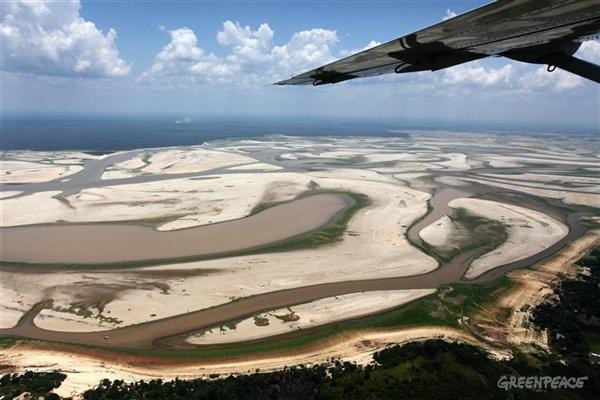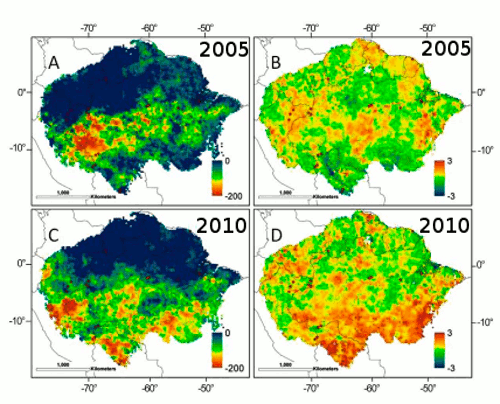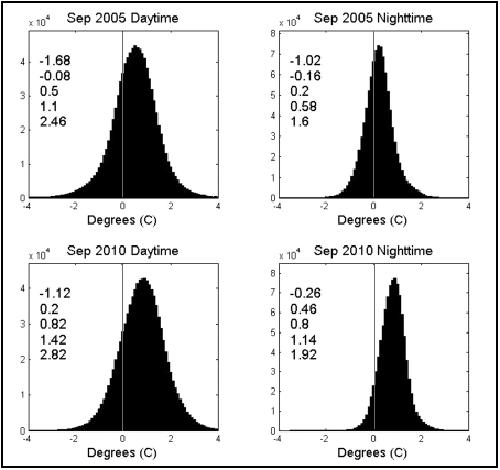Amazon Drought: Heat Stress Linked To Mass Tree Die Off In 2005 and 2010
Posted on 27 October 2011 by Rob Painting
In 2005 & 2010 the Amazon rainforest experienced two "once-in-a-century" droughts, adding to concerns that the rainforest may undergo massive die-back in the 21st century under global warming.
When discussing the potential for die-back of the Amazon rainforest, attention is often focused on reductions in rainfall, for obvious reasons; however, rising temperatures may also be a threat to the future prospects of the Amazon, as some research suggests that tropical rainforests exist near a high temperature threshold.
As if to underscore this potential threat, a recent peer-reviewed paper (Toomey 2011) finds that, aside from reduced rainfall, greater-than-normal surface temperatures in the 2005 and 2010 extreme droughts very likely contributed to a mass die-off of trees.

Figure 1 - 2010 drought in the Amazon, illustrating the severity of reduced rainfall experienced in parts of the basin. Picture from Greenpeace International.
Anomalous heat and tree death
Unlike earlier studies which have used satellite-detected greeness products (EVI) as an indicator of forest health, and because of prior problems with this method, Toomey (2011) considered another method. They compared satellite-based temperature and rainfall data with a network of Amazon rainforest (on-the-ground) observation plots (RAINFOR), to determine changes during the 2005 drought (plot observations were not available for 2010).
They confirm the results of two prevous studies (Lewis [2011]) & (Xu [2011]), which found that the 2010 drought was much worse than the 2005 (once-in-a-century) drought, and that reductions in rainfall affected a larger area in 2010 (left-hand column in figure 2). But they also discovered that surface temperatures (temperature anomalies) were greater in the 2010 drought and covered a far larger area of the Amazon (right-hand column in figure 2).

Figure 2 - The change in mean monthly maximum climatological water deficit (i.e. a measure of water stress in the rainforest) in mm, and September monthly temperature anomalies (°C) in (a & b) 2005, and (c & d) 2010. From Toomey (2011).
The significance of these heat anomalies is that in their statistical analysis, the study authors found that the greater-than-normal daytime temperatures of the 2005 drought explained 39% of the tree die-off. They also found that the additive effects of heat and moisture stress explained more of the tree die-off (65%) than rainfall deficits alone. It is therefore likely that the larger heat anomalies in 2010 (See figure 3) also go a long way toward explaining the greater tree die-off experienced that year.

Figure 3 - Frequency histograms of day and nighttime thermal anomalies at peak drought for all drought-affected areas. The 2.5th, 25th, 50th, 75th and 97.5th percentiles are shown in descending order (left-hand side) for each histogram. (e.g for Sept daytime 2005, 2.5% of observations fall below a thermal anomaly of -1.68°C, 25% fall below -0.08°C, 50% fall below 0.5°C, and so on)
Excessive heat the cause, not a symptom
Trees are responsible for recycling a lot of water, especially in the rainforest where the evaporative loss from trees causes considerable cooling of surface temperatures (think of how sweating causes your skin to cool). So the higher temperatures could be a result of trees dying and reducing the total evaporative cooling in the droughted areas.
To determine the direction of causality, the authors examined the relationship between NVDI (a satellite-based measure of rainforest health) and temperature anomalies in 2010 (this isn't possible with ground-based RAINFOR observations). They found the decline in rainforest health lagged that of the temperature anomalies by a month, suggesting that heat stress may be killing trees.
A dry, hot future for the rainforest?
As discussed in other SkS posts on the Amazon (see green box at bottom), the warming tropical Pacific and Atlantic Ocean are expected to shift rainfall away from the rainforest, especially during the dry season, causing it to suffer more frequent and more intense droughts in the future. This is supported by observations that a major drought in 1995, plus the 2005 and 2010 episodes were largely caused by warming in the tropical Atlantic Ocean (Espinoza [2011]).
Unlike earlier warm periods in Earth's past, the Amazon rainforest faces a combination of future stresses which it has never had to endure before. These will be discussed in detail in a future post, but the most obvious stressor is the speed at which tropical regions are warming.
With temperatures in the tropics rising at a rate twice that of the global average (0.26°C per decade) since the 1970's (Malhi & Wright [2004]), the prospect of a high temperature threshold for rainforest trees gives genuine concern that the Amazon rainforest may be approaching a tipping point, where it abruptly dies back and is replaced by savannah.
Related SkS posts: The 2010 Amazon Drought, Drought in the Amazon: A Death Spiral? part 1: seasons, , part 2: climate models & part 3:2005 & 2010 droughts.































 Arguments
Arguments























 0
0  0
0







Comments